Wool Month
Photo taken in the Old Fisherman’s Cottage, Clovelly, Devon.
October is British Wool Month, a moment championed by The Campaign for Wool and supported by its Patron, His Majesty King Charles III. This year, as the campaign marks its 15th anniversary, the focus is sharper than ever: to educate consumers to #CheckItsWool and #ChooseWool - making a powerful case for nature’s most sustainable, resilient, and versatile fibre.
In an industry grappling with the disastrous effects of microplastics and fast-fashion waste, wool is not just an alternative. As we discussed in last year’s article, "Wonderful Wool: Celebrating Wool Month," wool’s intrinsic properties - its durability, natural elasticity, and temperature regulation - make it an investment that stands the test of time, directly challenging the "take-make-dispose" model. I also love the fact that its antimicrobial properties mean it’s self cleaning – it doesn’t need to be washed as often as other fibres, and its wool fibres are naturally resistant to absorbing odours and dirt, so airing out a wool jumper after wear is often enough to freshen it up.
Wool: The Ultimate Circular Fibre
The biggest recent developments in the wool industry are centred on its flawless circular credentials. Wool is 100% natural, grown annually by sheep, and, unlike synthetic, fossil-fuel-derived fabrics, it is fully biodegradable in both soil and water, enriching the earth with nutrients and leaving zero trace of plastic pollution. This complete cycle from soil to soil is exactly what the textile industry needs.
Beyond apparel, British wool is moving into innovative sectors, including sustainable insulation for construction (It has a much lower environmental footprint than traditional synthetic insulation, it offers excellent thermal and acoustic insulation, and wool is naturally fire-retardant, making it safer for construction), and eco-friendly packaging, demonstrating its potential to replace polluting materials across various industries. Wool that is too coarse for spinning or knitting is often compacted into fertiliser pellets - these slowly release nitrogen and other nutrients into the soil, or mulch; used to suppress weeds, retain water, and improve soil porosity, often replacing plastic sheeting.
Increased consumer demand is also driving greater transparency, with certifications like the Responsible Wool Standard (RWS) ensuring animal welfare and sustainable land management practices are upheld across the supply chain.
Farm-to-Fashion: Pioneers in Traceability
The heart of British Wool Month is the farmers and makers who are leading the regenerative revolution. Two outstanding examples highlight how traceability and ethical production are becoming the blueprint for future fashion:
Katie Cotmarsh Knitwear is a powerful expression of farm-to-fashion traceability. Based on her organic farm, Katie grows all the fibre for her knitwear from her own flock of native breed sheep. Each piece is grown, spun, and finished within a small 130-mile radius, ensuring maximum localised value and minimum environmental impact. By using a botanical dye garden to cultivate her own colours and hand-crafting each piece in a no-waste, fully-fashioned process, Katie creates heritage knitwear that actively contributes to nature recovery.
Similarly, Fernhill Farm / Fernhill Fibre exemplifies a holistic, regenerative approach to farming. Owners Andy and Jen run a commercial flock of Romney Shetland sheep, selectively bred for fine, colourful fibre known as the LUSTRE FLOCK. Their farming methods focus on restoring biodiversity and soil health. Every fibre is grass-fed and blade-shorn, maintaining complete traceability through UK processors using gentle, chemical-free methods. They are proof that high-quality, aspirational wool can be produced while actively regenerating the land.
These businesses show that when you Choose Wool, you are not just buying a great garment; you are investing in British farming heritage, ethical land stewardship, and a cleaner future for the planet. As the industry shifts toward lasting value and environmental accountability, British wool stands ready as the natural, enduring fibre of choice.

